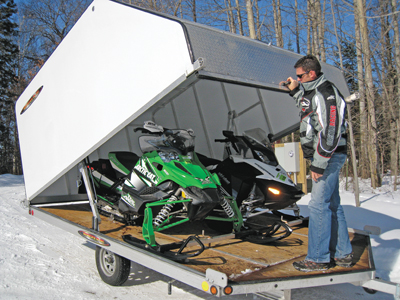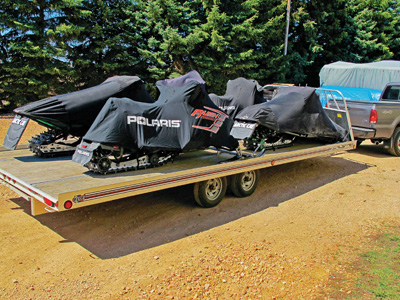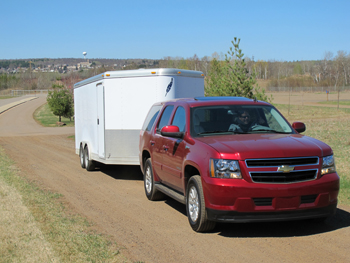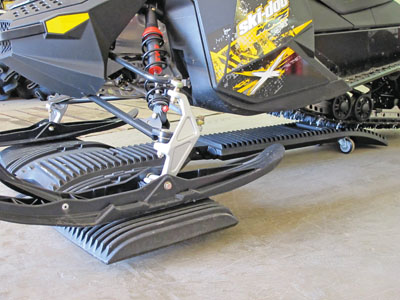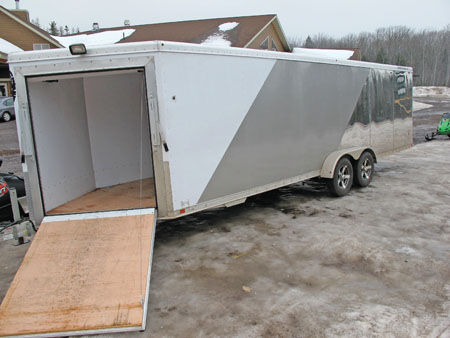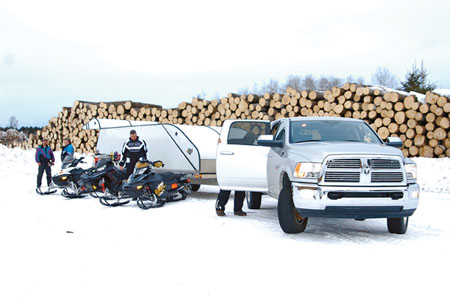Thanks to all-wheel drive (AWD), conversion vans could easily become a vehicle of choice for snowmobilers.
In my youth hockey days, I had a friend whose parents had a 1984 Ford E150 Waldoch conversion. The Loehr family was sought after to be the valet to away games — sure, they were great people, but their van was the most desirable, most spacious and most comfortable vehicle compared to the station wagons most other families drove at the time. It was a fight between the 12-year-olds to get a seat in the Loehr van.
If memory serves, however, it was also a fight for Ralph, the patriarch, to keep his rear-wheel drive van on the road in slippery and snowy conditions.
AWD To The Rescue
We spent time with a 2005 Chevrolet Express 1500 Waldoch conversion van. Waldoch has been in the customizing business since 1974 and produces conversion vans, sport trucks, sport-utility vehicles and RVs.
The base chassis for the van was a Chevrolet H1500 AWD chassis. Ours was equipped with a 5.3-liter Vortec V8 rated at 295 hp and 330 pound-feet of torque. Engine power is sent through a 4-speed transmission and full-time AWD transfer case. The axle ratio is 3.73:1, and we were curious how that tall, highway-suited gearing would stack up to towing.
Thankfully, the tow/haul mode on this driveline combination works well. Like other systems, the mode allows the engine to rev to peak power before upshifting. The curious thing about the tow/haul mode on this transmission is that it performed better than other GM systems we’ve tried recently — the GMC Sierra 1500 Denali and the Hummer H2 SUT. With the 6.0 liter V8 and the heavier-duty transmissions in both the latter vehicles, we experienced occasional driveline lash. Not so with the 5.3.
The van’s gearing is 3.06 for first. It was able to get itself and our loaded 4-place Sno Pro enclosed trailer moving. The load was an estimated 4,000 pounds, about two-thirds of the van’s 6,200-pound towing capacity. Fourth gear is a .70 overdrive, and, by no surprise, it had to be locked out of use on the column selector for improved towing performance — using the 1:1 ratio of third for the two-ton grunting. By using third and turning the engine higher in its power range we obviously used more fuel. Our observed miles-per-gallon during towing was 8.2.
Suspension is quiet and stable at any speed, and the rear springs had a nice progression that soaked up the additional tongue weight and didn’t bottom harshly. When more suspension travel was used on larger bumps, the front end got lighter to a degree greater than does a half-ton pickup. This is not a surprise, either, because trucks are equipped for higher payloads in the rear. We would prefer a bit more road feel through the wheel, especially when towing heavy loads. It was never to the point of feeling unstable or unsafe, even at 70 mph.
Weight is carried low on a relatively wide chassis on full-size vans. It makes for a stable, confident-feeling tow vehicle. Trailers had little influence on changing our vehicle course. Part of this impressive immunity to most trailer behavior was the tires. Waldoch equipped this vehicle with 20-inch custom wheels, which were matched with low-profile, stiff-sidewall tires. There was little flex or wander coming from the contact patches.
To vans, a larger enemy than trailers is wind. Huge, side-profile surface areas make driving in crosswinds a chore. Add slippery conditions, and keeping a van towing a heavy trailer between the road stripes is a full-time job.
That’s where we see another great benefit of AWD. In addition to being better equipped for winter with power to all the corners, the AWD adds to the overall stability of the vehicle in wet or loose terrain and on highways.
During highway use, the Waldoch conversion was quiet and comfortable. Waldoch added effective noise-reducing insulation to isolate engine, road and chassis noise. At highway speeds, wind noise overpowers most audible mechanical chatter. A rumble comes from the tailpipe while accelerating or towing with the overdrive locked out, but it isn’t enough to be distracting to anyone who tries to enjoy a quiet ride inside.
Passing The Time
It’s easy to pass the time when driving a van equipped with all sorts of road-going entertainment. The Summit LX package on our Waldoch conversion had a 15-inch flat-panel LCD that folds neatly into the headliner when not in use. Passengers can drop a DVD into the rear surround sound entertainment system. Auxiliary inputs with an integrated power inverter can power gaming systems. Two pair of infrared headphones allow use of both stereo systems, or the XM radio.
Personal overhead reading lights, lights in the custom bay-window valances and soft, center overhead lighting are all controlled from a driver overhead command and control center. Another nice touch was the rear view camera, with a small LCD screen integrated into the rear-view mirror.
Seating in this Waldoch package was typical of conversion vans, with captain’s chairs for the driver and three passengers — one front and two mid. The rear featured a sofa with seating for three which was power slide and power recline. All seating was ultra-plush leather, and cushions for the driver and front seat passenger were 6-way power and heated. Behind and under the sofa there is ample storage space for snowmobile gear and coolers.
Waldoch customers can choose a brand and weight class of vehicle and then go nuts with the extensive options list. Ours was a vehicle in which we wanted to remove our shoes when entering. Padded, continuous filament nylon carpeting was comfortable. Designer window shades were among the treatments that provided privacy. Get in, get comfortable and wait until arrival at a destination without caring how long it takes.
On-road luxury
While the half-ton van chassis was not as rugged as a half-ton pickup chassis, its performance was adequate for our two tons of fun in tow. Thanks to the addition of all-wheel drive, it fits its label as a utility vehicle and its driveline and chassis are up to the tasks of medium-duty towing. When trimmed out as a Waldoch conversion, there was no arguing it fit its billing as a luxury utility vehicle.
In seasons when snowfall is elusive, gathering a crew to road-trip to where the snow is hiding will be effortless when they know what you’re driving. Just like the Loehr family, the largest problem with owning a Waldoch conversion is that you’ll be stuck driving everywhere.

